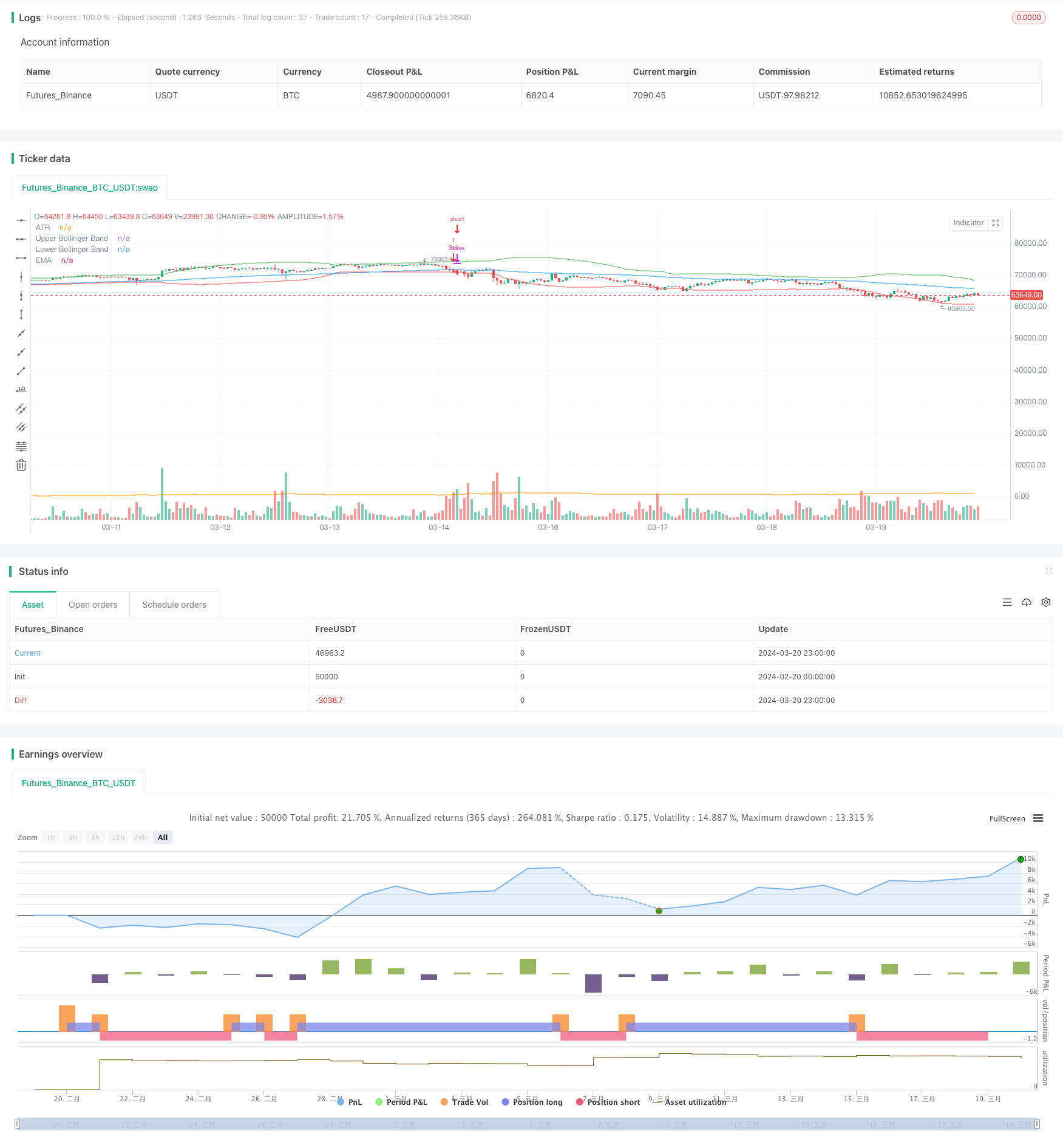
概述
该策略结合了布林带和指数移动平均线(EMA)两个技术指标,旨在捕捉市场的趋势性机会。策略的主要思想是利用布林带来判断价格是否处于相对高位或低位,同时使用EMA作为趋势的过滤条件,最终根据一定的逻辑规则来进行交易决策。
策略原理
计算布林带:通过计算收盘价的简单移动平均线(SMA)和标准差,得到布林带的上轨和下轨。上轨为SMA加上一定倍数的标准差,下轨为SMA减去一定倍数的标准差。
计算EMA:根据设定的EMA周期,计算收盘价的指数移动平均线。
计算ATR:根据设定的ATR周期,计算平均真实波动幅度(ATR)。
买入条件:当收盘价同时高于EMA和布林带上轨时,触发买入信号。
卖出条件:当收盘价跌破布林带下轨或EMA时,触发卖出信号。
执行交易:根据买入和卖出条件,执行相应的多头或空头交易。
绘图:在主图表上绘制EMA和布林带,在副图上绘制ATR。
优势分析
布林带能够有效地捕捉价格的波动范围,帮助判断价格是否处于相对高位或低位。
EMA能够反映价格的趋势方向,可以用来过滤布林带产生的交易信号,提高交易的准确性。
ATR可以衡量市场的波动性,为交易决策提供参考。
策略逻辑清晰,易于理解和实现。
通过调整布林带和EMA的参数,可以适应不同的市场环境和交易品种。
风险分析
在震荡市或趋势反转时,该策略可能会产生较多的假信号,导致频繁交易和损失。
策略对参数的选择较为敏感,不同的参数设置可能会导致不同的交易结果。
策略没有考虑交易成本和滑点,实际交易中可能会影响策略的收益。
策略缺乏对风险的管理,如止损和仓位控制等。
优化方向
引入趋势确认指标,如MACD、DMI等,以进一步验证趋势的可靠性,减少假信号。
优化参数选择,可以通过历史数据测试不同的参数组合,找出最优的参数设置。
加入风险管理措施,如根据ATR设置动态止损,或根据市场波动性调整仓位大小。
考虑交易成本和滑点的影响,在回测和实盘中加以考虑,提高策略的实用性。
结合其他技术指标或基本面因素,构建更加全面和稳健的交易策略。
总结
布林带+EMA趋势跟踪策略通过结合布林带和EMA两个技术指标,以捕捉市场的趋势性机会。该策略的优势在于逻辑清晰,易于理解和实现,通过调整参数可以适应不同的市场环境。然而,策略也存在一些风险,如在震荡市或趋势反转时可能产生较多假信号,对参数选择敏感,缺乏风险管理措施等。为了进一步优化策略,可以考虑引入其他趋势确认指标,优化参数选择,加入风险管理措施,考虑交易成本和滑点的影响,以及结合其他技术指标或基本面因素。总的来说,该策略为趋势交易提供了一个基本的框架,但在实际应用中还需要根据具体情况进行优化和改进,以提高策略的稳健性和盈利能力。
/*backtest
start: 2024-02-20 00:00:00
end: 2024-03-21 00:00:00
period: 1h
basePeriod: 15m
exchanges: [{"eid":"Futures_Binance","currency":"BTC_USDT"}]
*/
//@version=4
strategy("Bollinger Bands + EMA Strategy", overlay=true)
// Bollinger Bands settings
bollinger_period = 50
bollinger_width = 2.0
// EMA settings
ema_period = 100
// ATR settings
atr_period = 14
atr_factor = 1.8
// Calculate Bollinger Bands
sma_source = sma(close, bollinger_period)
std_dev = stdev(close, bollinger_period)
upper_band = sma_source + bollinger_width * std_dev
lower_band = sma_source - bollinger_width * std_dev
// Calculate EMA
ema_value = ema(close, ema_period)
// Calculate ATR
atr_value = atr(atr_period)
// Buy condition
buy_condition = close > ema_value and close > upper_band
// Sell condition
sell_condition = crossunder(close, lower_band) or crossunder(close, ema_value)
// Plotting Bollinger Bands and EMA
plot(ema_value, color=color.blue, title="EMA")
plot(upper_band, color=color.green, title="Upper Bollinger Band")
plot(lower_band, color=color.red, title="Lower Bollinger Band")
// Execute orders based on conditions
if (buy_condition)
strategy.entry("Buy", strategy.long)
if (sell_condition)
strategy.entry("Sell", strategy.short)
// Plot ATR on separate pane
plot(atr_value, color=color.orange, title="ATR", style=plot.style_stepline, linewidth=1, transp=0)